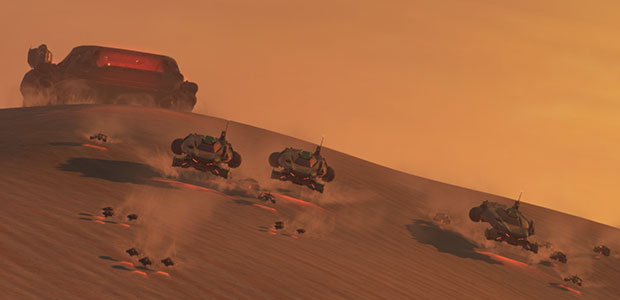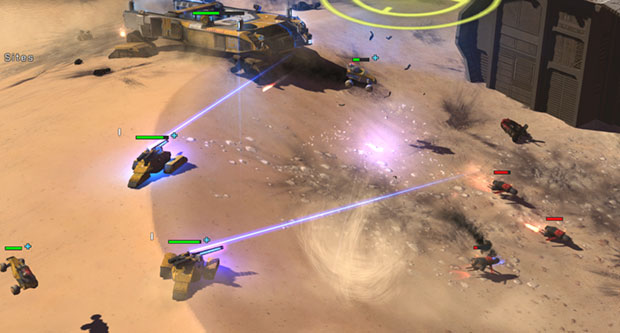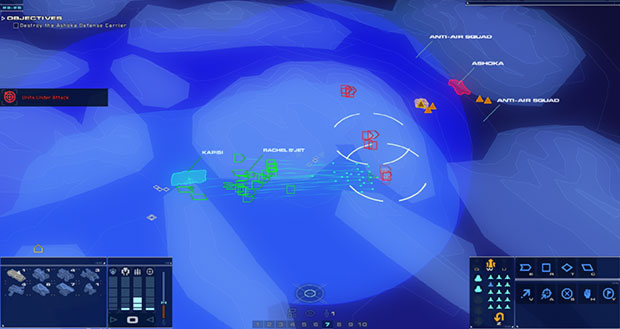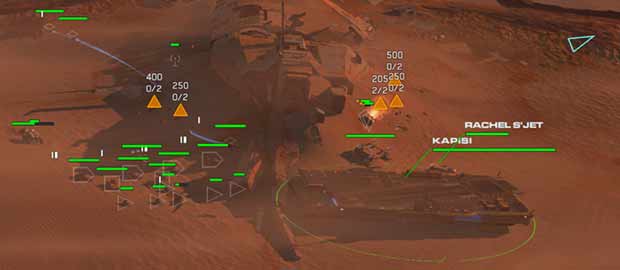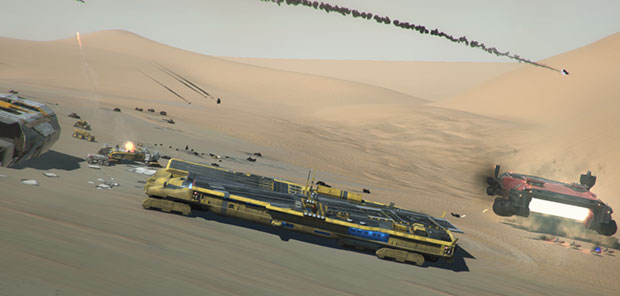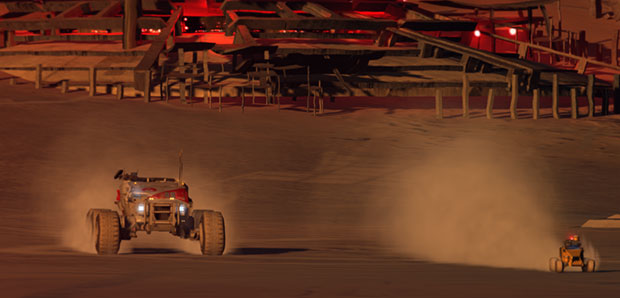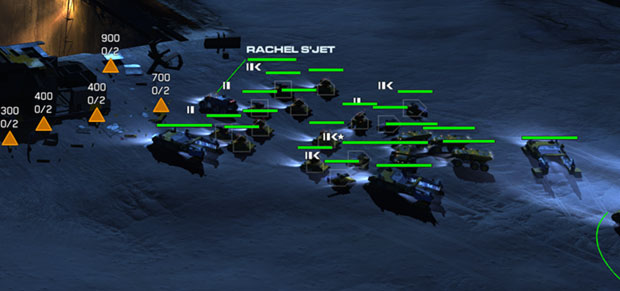Wot I Think - Homeworld: Deserts Of Kharak
Non-space oddity
Homeworld: Deserts of Kharak [official site] is a prequel to the legendary Homeworld space real-time strategy games, but this time - heresy! - set on land, as the Kushan race battle angry clans to reclaim ancient technologies found on the sandy planet they currently call home. While some of its developers (including studio boss and former Relic art lead Rob Cunningham) worked on the original games, this first began life as the unrelated 'Hardware: Shipbreakers', before morphing into the free to play multiplayer 'Homeworld: Shipbreakers' and then finally to the traditionally-sold, singleplayer and multiplayer package it is now. Deserts of Kharak has some bloody big boots to fill - can it possibly manage it?
Note: This piece primarily focuses on the solo campaign, as there wasn't much multiplayer to be had pre-release.
I do admire the wanton self-destructiveness of taking one of the most quintessential space games then removing space from it. As well as being mischievous, hopefully it also speaks to a determination to only take Homeworld to space again once they're sure they can do it absolutely right. Deserts of Kharak, you see, is a landlubbing prequel to Relic's much-loved Homeworld series, starring giant sandcrawlers and assorted buggies, tanks and jets as they battle across the titular, entirely arid planet. It manages to be more Homeworldy than one might have suspected, as well as evoking fond memories of Dune II and the sudden realisation that someone really should make a Mad Max RTS.
It's UI, soundtrack and craft design which primarily make a game mostly about tanks fighting in the desert feel most like Homeworld, but Kharak also shares a certain sense of scale and refreshingly slow pacing with its great ancestor. There are several flies in its gently undulating ointment, but the unhurried, almost dreamlike speed of its action is what I most like about it - a welcome change of pace, a break with current RTS tradition to become ever-more frantic.
This is not to say that Kharak doesn't become extremely tense and involved, but rather that you're not going to be punched into the ground if you've not been all go, all the time. However, despite its unhurried stride, it's pretty big on the keyboard shortcuts and the use of a Supreme Commander-style tactical map, plus you will find yourself fighting the awkward camera controls on a regular basis, so don't expect an easy ride even if it's not making you all panicky and sweaty moment-to-moment.
Going back to commonalities with Homeworld, I think in this case its pretty but abstracted UI - all icy blue geometric shapes for the build actions - works against Kharak. It made some sense for the inherent unfamiliarity of various different spaceship classes, but scout buggies and tanks and fighter planes are well-worn terrain, and I'd really rather be clicking a little aeroplane icon than going "um, so were they the diamond or the parallelogram?"
Some UI aspects also look pretty fuzzy if you're playing above 1080p, and while clearly that's not an issue for most people, it all goes into the pot - my overall sense is that interface clarity and presentation has been sacrified in favour of clawing back more Homeworldiness. I spent more time than I'd like playing on the well-implemented tactical map, partly because the big-picture was simply more practical on what are often very large levels, but mostly because the main-game camera wasn't what it could be.
Add in unskippable cutscenes (of which there are a great many, before, during and after missions), sporadically malfunctioning unit AI and a few glitches (for instance, I had to restart a mission because the game camera got itself locked into cutscene mode), a limited number of maps and a total dependence on sandy environments, and what's otherwise a pretty and thoughtful strategy game does occasionally fall into frustration or even tedium.
Kharak's absolutely on the side of the angels despite this. While what it's doing is fairly routine for strategy game, how it feels is not. It might not quite have the visual impact of its forefather, but it does a solid job of making its desert planet feel large, lost and lonely, and its hovering, oddly-angled units eschew conventional tankiness in favour of spaceshipy design cues from the original games. The Carriers, your mobile headquarters, are a joy - giant, mobile runways or docking bays, in some ways scaled down versions of Homeworld motherships, but at the same time even more bizarro-industrial. They play a more active role than the motherships too - rolling deathwagons as much as bases.
And, without wanting to give away too much plot, spaceships of a sort do make an appearance, provoking the same Chris Fossish techno-joy of the original games. While the between-mission cutscenes are a mixed bag of concept art and rotoscope-esque pseudo-animation, the in-engine ones make dramatic use of the crafts and their desolate environment, aided by the same judicious use of cinematic camera angles and cuts as the original Homeworlds were renonwed for. The vast majority of screenshots in this piece come from those scenes, because grabbing shots of them was irresistible. If nothing else, Deserts of Kharak is a strong riposte to the idea that a sci-fi RTS can only be beautiful if it's in space.
The stand-out element, however, is the sound design. Over long years, we've miserably adjusted to the idea that all you can do with unit chatter is have each guy say something funny or militaryesque when you click on them, but Kharak casually rewrites the rules. Either by selecting units or by just hanging around and listening, you'll hear the units talk amongst themselves. Select a unit and while sometimes they'll just give an 'acknowledged', other times a more involved, context-sensitive reaction to whatever you've ordered them to do. An endangered unit might thank you for sending in air support. A ship which has spotted incoming enemies will tell you what type of craft they are. Idle units will chatter amongst themselves at length about faults and tactics.
As well as successfully giving you a general sense of what's going via audio alone, it sounds natural and responsive, rather than mechanical and repetitive - all adding to that sense that this is a large and well-oiled military machine, not just some cute little guys who popped out of a magic factory. Kharak might not otherwise be a landmark moment for the genre, but its unit audio does set new standards. It's going to be so disappointing to play a strategy game filled with tinned quips after this.
It's a very pleasant thing to have on one's screen and speakers then, but despite its aesthetic successes Kharak's greatest shortcoming is that the experience becomes over-familiar mid-way through the campaign. That the maps all look so similar isn't really the cause of this (especially if I'm arguing that Kharak brings back fond Dune II memories), and in any case they do wring some surprising visual variety from the setting, but rather that it's so often about long, glacial treks through sandy valleys, sporadically facing off against the same handful of enemy types and micro-managing the collection of arbitrarily-located resources. The rock-paper-scissors unit balancing works well and leads to some dramatic skirmishes, the skies peppered with glorious vapour trails of elegantly deadly missiles, but there's a lot of rinse and repeat here.
There are some novel units and clearly a lot of effort has been made to bless each singleplayer mission its own structure with its own tactical twists, but sitting back from it after a couple of days of play, I do feel that, moment-to-moment, Kharak feels pretty much the same. While, for me, that moment is a far more thoughtful and more aesthetically-pleasing one to that offered by most in its genre, I did sometimes feel as though I was grinding through the levels, waiting for some pay-off that never quite came. It's a smallish game on a large stage, basically, and while by and large it gets away with it, sometimes you can tell how stretched it is.
I particularly wish it had more character to it beyond the craft designs: its sands evoke Dune but it doesn't pursue the strangeness or the deadliness, while some of its vehicles and camera angles seem to come from the Mad Max playbook but aren't paired with any of the raucousness. The characters in the cutscenes are few and short on personality; it might not have the posturing of Starcraft II but it does share its lore-trumps-all sensibility.
There's a very solid core here though - this is not the quickfire cash-in or licensed-after-the-fact awkwardness it could have been, given its origins. It really does feel like a Homeworld game, despite the transition from a galactic scale to a terrestrial one. I fear the relative lack of variety handicaps its potential to be a multiplayer hit and thus enjoy the sort of lifespan that the Homeworlds did/do, but as a singleplayer offering it's substantial and satisfying, so long as you can put up with some AI wobbles and a certain amount of going through the motions. As for its part in Homeworld lore, well, there's a lot for fans to pick over/yell about, but if you're into spaceships-as-mythology you should get something out of it.
In terms of being an RTS you can play even if you've never been anywhere near a Homeworld, yep, it is. Some of the major cutscenes won't mean as much, but then again they're so dry that I'm not sure they'd connect even were they about a brand new universe, and in any case you don't need any of that to justify or explain war machines fighting in the desert, which is what this game really is. And it's damn good at it.
Deserts of Kharak does manage to be standalone as well as prequel to an old series, and if you're tired of the twitchy frenzy which grips so many latter-day RTSes, Kharak is a smart and beautiful destination whether or not you still dream of Hiigara. It might be set on land, but by recent RTS standards it's nonetheless reaching for the stars.
Homeworld: Deserts Of Kharak is out now for Windows via Steam and Humble.


